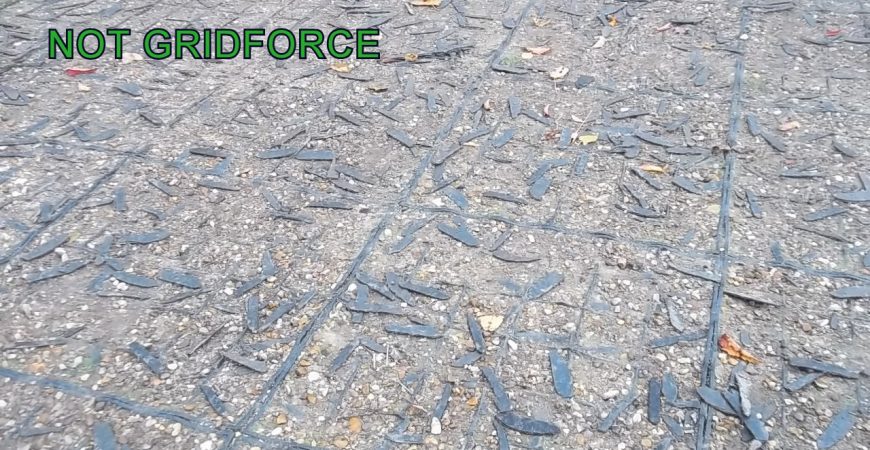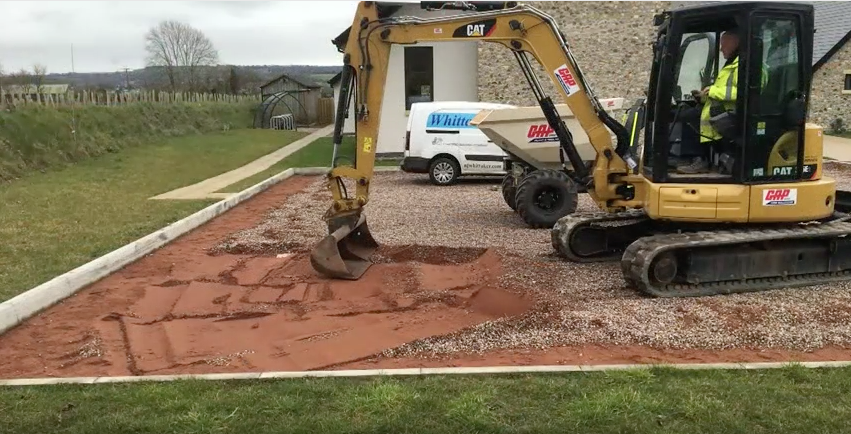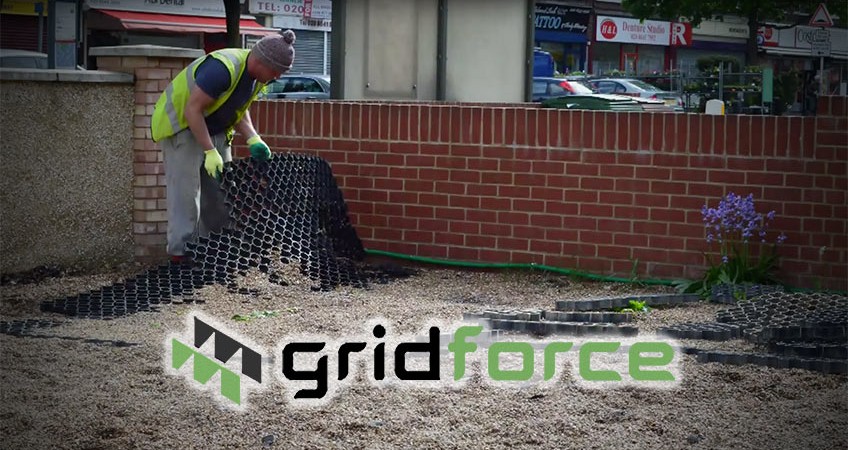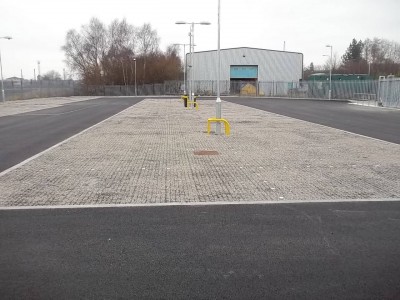
From Gridforce: Competitors grid manufactured from HDPE
The picture above is a competitors grid manufactured from HDPE, as you can see all the black bits are plastic that have broken off. When it comes to plastic pavers on the market, there is often a discussion about the difference in the type of plastic used to manufacture the paver.
Most plastic pavers on the market are manufactured from what is known as a HDPE (high density polyethylene), which is a polyethylene thermoplastic made from petroleum. High density polyethylene is a readily available plastic, therefore economical in cost. Although HDPE has a high tensile strength, the material is rigid, and in sub-zero temperatures and the freeze thaw cycle; the plastic becomes more brittle and is subject to stress fractures and cracking.
Gridforce is manufactured from LDPE (low density polyethylene). LDPE is a thermoplastic made from the monomer ethylene and is more difficult to get hold of, consequently a more expensive product. LDPE is less brittle and more flexible, therefore when used in a car parking situation can cope more effectively with the lateral stress movement created when being trafficked.
When grid pavers are tested for strength, they are usually analysed when filled with aggregate. As a result, this doesn’t give a true reading of the strength of the plastic as it is relying on the gravel. Gridforce is however tested empty. This means that the tensile strength can only increase when the pavers are filled.




 The Challenge
Network Rail needed extra parking for their new industrial units alongside the railway track in Warrington. Their main concern was the run off of water from the rail line flooding the new car park beneath, and therefore needed a SuDS compliant solution.
As an alternative to traditional tarmac carparks that would require expensive drainage systems, consider the use of the Gridforce permeable paving system in conjunction with the use of tarmac. Gridforce products fully comply with SuDS regulations and therefore can act as run off from the tarmac areas. This eliminates the requirements for underground drainage.
Prior to the work, the area was an un-used grass land comprising of excess soil mounds and weeds.
Project
Network Rail Car Park
Application
1005m2 gravel finish
Product
GF 50 black
Location
Slutchers Lane, Warrington
The Solution
The land was prepared for laying the grid by removing excess grass land and digging down to the substrate. MOT type 3 was then laid and compacted to provide a firm surface and allow for adequate drainage. A sheet of geotextile membrane was laid on top of the sub-base to prevent any further weed growth and act as a separating layer. This was then covered with a layer of sand providing a levelling layer and forming a bedding layer for the grid. The GF50 pavers were laid and connected into place to cover the required area. The grid was then in filled with 14mm angular gravel as selected by the client.
Conclusion
The installation work on this car park was carried out in December 2012 and within a short space of time the original grass waste land had been transformed and was available for use. The Gridforce ground reinforcement system allows vehicular stability, water infiltration and the reinforced gravelled finish the customer required.
Client Benefits
The Challenge
Network Rail needed extra parking for their new industrial units alongside the railway track in Warrington. Their main concern was the run off of water from the rail line flooding the new car park beneath, and therefore needed a SuDS compliant solution.
As an alternative to traditional tarmac carparks that would require expensive drainage systems, consider the use of the Gridforce permeable paving system in conjunction with the use of tarmac. Gridforce products fully comply with SuDS regulations and therefore can act as run off from the tarmac areas. This eliminates the requirements for underground drainage.
Prior to the work, the area was an un-used grass land comprising of excess soil mounds and weeds.
Project
Network Rail Car Park
Application
1005m2 gravel finish
Product
GF 50 black
Location
Slutchers Lane, Warrington
The Solution
The land was prepared for laying the grid by removing excess grass land and digging down to the substrate. MOT type 3 was then laid and compacted to provide a firm surface and allow for adequate drainage. A sheet of geotextile membrane was laid on top of the sub-base to prevent any further weed growth and act as a separating layer. This was then covered with a layer of sand providing a levelling layer and forming a bedding layer for the grid. The GF50 pavers were laid and connected into place to cover the required area. The grid was then in filled with 14mm angular gravel as selected by the client.
Conclusion
The installation work on this car park was carried out in December 2012 and within a short space of time the original grass waste land had been transformed and was available for use. The Gridforce ground reinforcement system allows vehicular stability, water infiltration and the reinforced gravelled finish the customer required.
Client Benefits
 Project
Kew and Ham Sports Association
Application
2300m2 gravel finish
Product
GF 40 black
Location
Twickenham
Installers
Gridforce Installation Team
Project
Kew and Ham Sports Association
Application
2300m2 gravel finish
Product
GF 40 black
Location
Twickenham
Installers
Gridforce Installation Team
 The Challenge
Continuing its policy of expansion, Twycross Zoo commenced construction of its new £7,000,000 Himalaya Visitor Welcome Centre in March 2009.
Himalaya was designed to emerge naturally from the landscape, and the use of local sustainable materials, ground source heating and landscaping to attract biodiversity were considered fundamental to the development.
Design and construction of Himalaya was entrusted to Kier Marriott Construction Ltd, through its Nottingham office. Various options were considered for the car parking, but bearing in mind that materials used on the previous car parking areas had not always been an unqualified success, the Gridforce ground reinforcement system was selected and approved. After a 12 month construction period, the Himalaya Centre opened to visitors in March 2010.
Application:
Parking for new visitors centre
Location:
Twycross Zoo, Leicestershire
Installation Date:
Early 2010
Client:
Kier Marriott Construction Ltd (Nottingham) -appointed design and build contractor for Twycross Zoo.
Gridforce Solution
2060m2 of Gridforce GF40 pavers in black, manufactured from 100% recycled plastic.
Construction Details
The Challenge
Continuing its policy of expansion, Twycross Zoo commenced construction of its new £7,000,000 Himalaya Visitor Welcome Centre in March 2009.
Himalaya was designed to emerge naturally from the landscape, and the use of local sustainable materials, ground source heating and landscaping to attract biodiversity were considered fundamental to the development.
Design and construction of Himalaya was entrusted to Kier Marriott Construction Ltd, through its Nottingham office. Various options were considered for the car parking, but bearing in mind that materials used on the previous car parking areas had not always been an unqualified success, the Gridforce ground reinforcement system was selected and approved. After a 12 month construction period, the Himalaya Centre opened to visitors in March 2010.
Application:
Parking for new visitors centre
Location:
Twycross Zoo, Leicestershire
Installation Date:
Early 2010
Client:
Kier Marriott Construction Ltd (Nottingham) -appointed design and build contractor for Twycross Zoo.
Gridforce Solution
2060m2 of Gridforce GF40 pavers in black, manufactured from 100% recycled plastic.
Construction Details